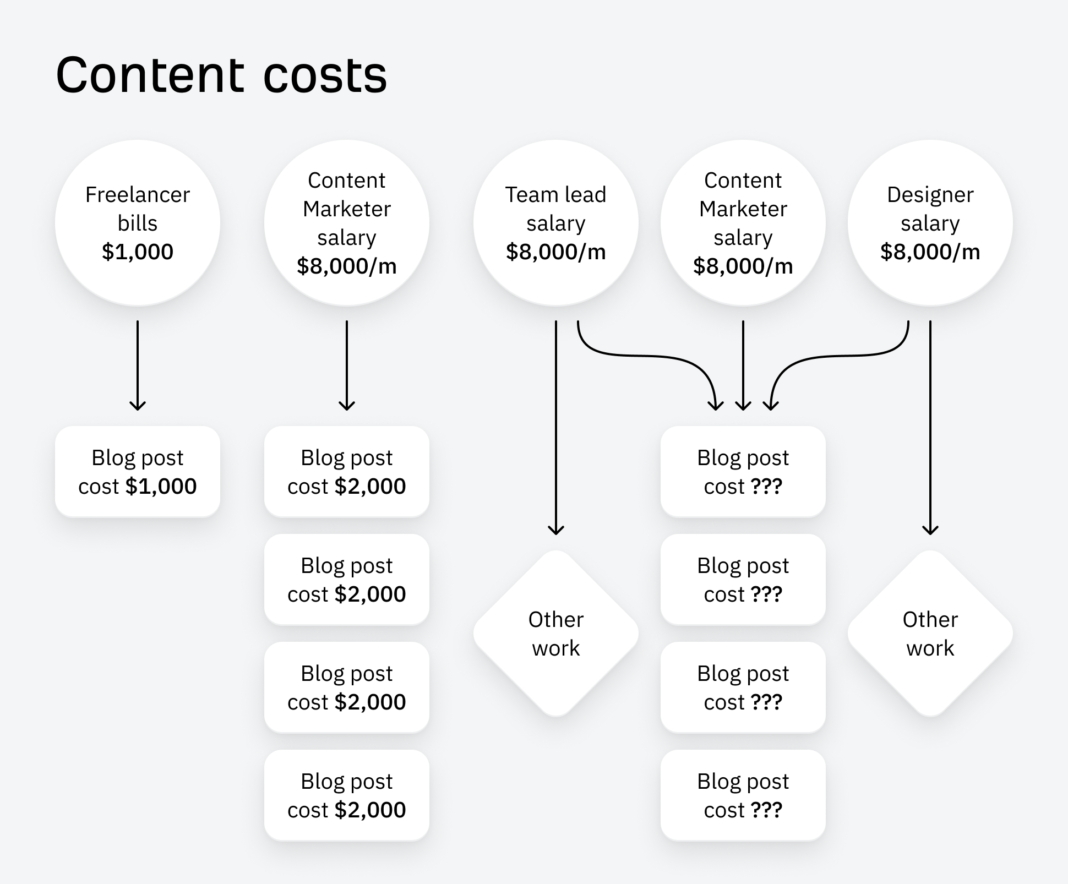The components for calculating ROI is so easy that I’ll share it proper right here, within the article introduction:
((Return from content material − price of content material) / price of content material) * 100In case your content material advertising generated $10,000 in gross sales and value $2,000 to create, that’s an ROI of 400%:
(($10,000 - $2,000) / $2,000) * 100 = 400%Though the mathematics is straightforward, really doing this train in actual life is difficult, for just a few causes. A very powerful: it’s fairly laborious to place a greenback worth on each single good thing about your content material advertising.
I’ll clarify why, after which present you 3 sensible strategies for rapidly figuring out your content material advertising ROI.
If you wish to speak convincingly about ROI to your boss or your shoppers, it helps to know these three factors:
If your entire content material advertising is outsourced from freelancers or businesses, it’s comparatively straightforward to work out how a lot it prices: it’s the quantity they invoice you.
In case you have a wholly in-house group, with group members dedicating 100% of their effort to content material, prices are equally simple: it’s their salaries.
However issues can get somewhat sophisticated if you happen to supply content material from a number of sources (like a mixture of freelancers, businesses, and in-house group members), or if a number of individuals contribute to your content material in comparatively small methods (like a designer dedicating a 3rd of their time to content material, and two thirds to product advertising).
However that is nonetheless easy in comparison with our subsequent complication:
The obvious good thing about content material advertising: it attracts new prospects. We will theoretically add up all the brand new prospects who discovered and acquired our product due to our content material advertising, and work out how a lot cash they spent (I clarify how within the subsequent part).
However content material has plenty of different advantages which can be much less straightforward to measure. It can:
- Encourage upsells and growth. By sharing product suggestions and new use instances, content material can present the nudge wanted to show free customers into energy customers, or “Lite” plan prospects into “Superior” plan customers—like My 5 Favourite Ahrefs Use Instances for Content material Entrepreneurs.
- Get monetary savings on buyer help. Content material might help reply buyer questions earlier than they turn out to be help queries, like the numerous guides we’ve printed to assist customers perceive how metrics like Visitors Worth are calculated, and the way they are often used.
- Construct model recognition and affinity. Content material may give your model a voice, sharing the motivations and beliefs that underpin the services or products you promote. We typically like to purchase from firms we respect, so “model affinity” could make an actual distinction to the underside line.
- Makes paid search promoting more practical. Sending paid search site visitors to articles as an alternative of “conventional” touchdown pages can scale back the price of clicks (one thing we’ve carried out for articles like our information to key phrase analysis).
- Assist different pages carry out higher. A web page that generates a ton of backlinks however no gross sales (like our listing of website positioning statistics) can nonetheless contribute to income by serving to different “cash” pages rank higher for his or her goal key phrases.
Many of those advantages are just about invisible—how do you measure help queries that content material stopped from current?—however very actual. Irrespective of the way you calculate ROI, there’s a great likelihood you’ll be undervaluing its affect.
Which brings us to our subsequent complication:
Figuring out the function content material performed in a sale is named “attribution”, and it’s fairly difficult to pin down.
Did somebody convert due to an article or regardless of it? After they learn a number of articles, which had the most important affect? If somebody buys due to an advert, ought to we nonetheless credit score the weblog submit they learn beforehand?
Buyer journeys are additionally hardly ever as simple as we’d hope. One individual may learn 50 articles and by no means purchase something; one other may learn a single article, disappear for a 12 months, and instantly purchase. What function did content material play in these journeys?
There are other ways of measuring attribution to assist with a few of this uncertainty:
- First-touch attribution credit the first piece of content material a customer engages with earlier than changing.
- Final-touch attribution credit the final piece of content material.
- Multi-touch attribution tries to credit score each piece of content material that was concerned within the shopping for course of.
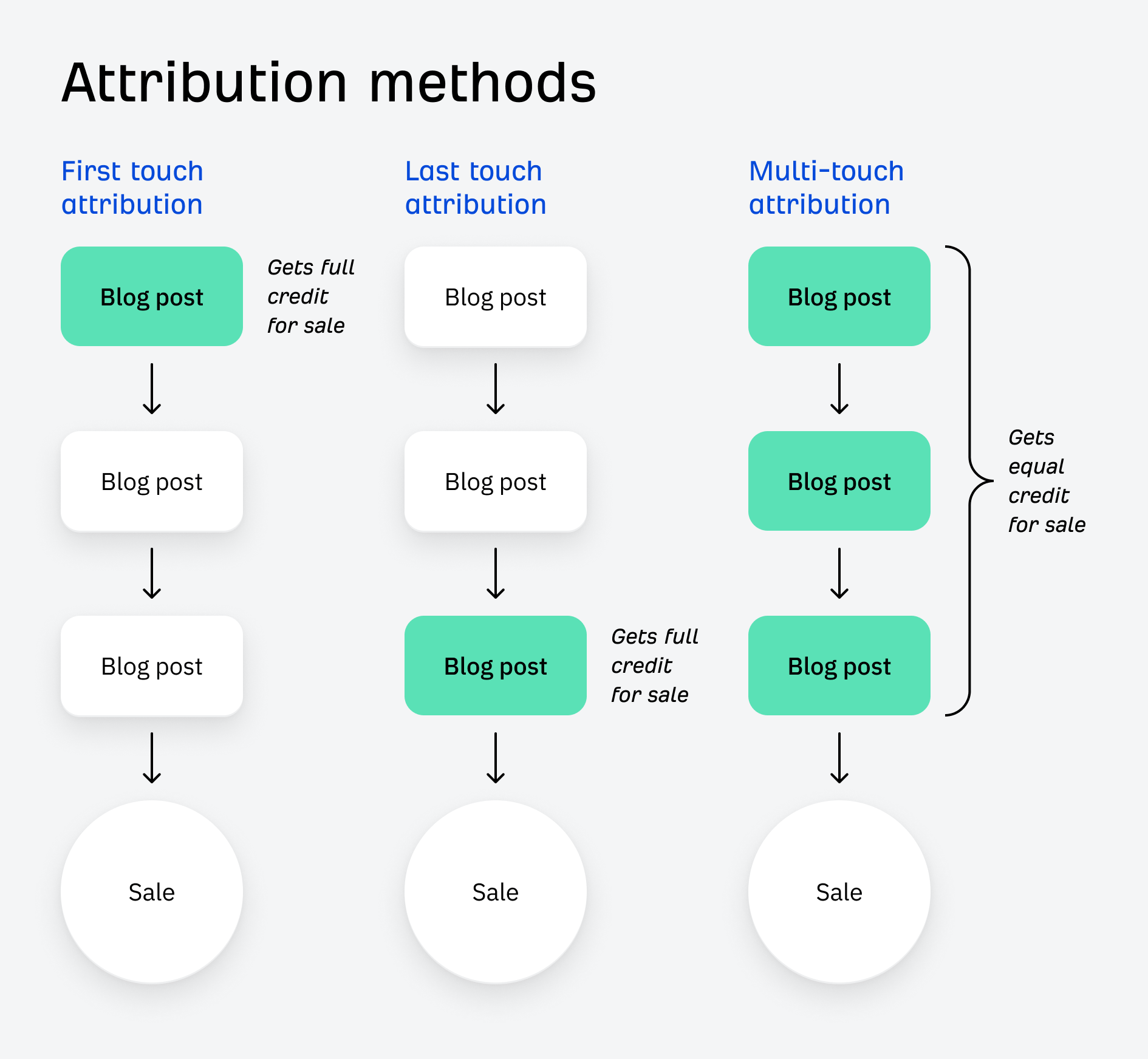
However in all instances, attribution isn’t excellent: we simply can’t measure each interplay somebody has with our content material.
In an ideal world, we’d know precisely how a lot income each weblog submit generated for our enterprise. To calculate ROI this manner, we will use a components as follows:
Return from content material advertising = (New prospects from content material * ACV)
To work this out, we have to calculate the variety of new prospects generated by our content material in a given interval. When you don’t know this determine, you’ll have to arrange some type of dialog monitoring in software program like Google Analytics, permitting you to trace the variety of those who full a desired motion in your weblog submit (like filling in a type or beginning a free trial)
Usually, guests gained’t purchase immediately out of your weblog submit, so that you’ll have to observe:
- The variety of conversions generated by your content material (e.g. free trial signups or demo requests), and
- The variety of these conversions that went on to turn out to be paying prospects.
Within the picture under, we will see which pages guests land on earlier than buying a product. We will additionally see the conversion fee and the income attributed to the conversions:
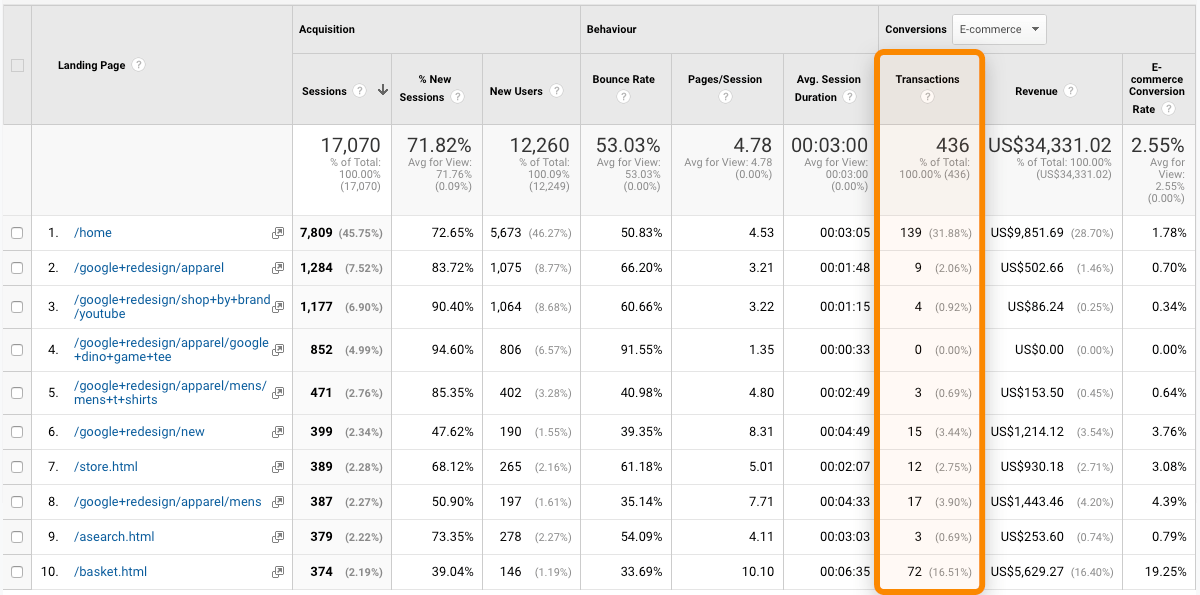
Subsequent, we have to calculate ACV: common buyer worth. This refers back to the typical quantity that prospects spend with our firm over the course of their relationship with us.
If we promote one product, and most prospects purchase simply as soon as, our ACV would be the worth of our product. If we provide a number of merchandise or add-ons, and prospects purchase commonly or arrange subscriptions, then our ACV shall be rather a lot larger.
Let’s assume that our conversion evaluation exhibits that we had 1,000 free trial signups from our content material in February, and 100 of these free trials turned paying prospects. If our ACV is $2,000, we will plug these numbers into our components to calculate a return from content material of $200,000:
(New prospects from content material * ACV) = 100 * $2,000 = $200,000This technique is the gold commonplace of ROI calculations, however (due to the issues talked about above) calculating ROI like this may be extraordinarily sophisticated.
On the different finish of the spectrum, right here’s a fast and straightforward technique that takes about 30 seconds utilizing Ahrefs:
Return from content material advertising = (month-to-month site visitors worth * content material lifetime in months)
As an alternative of figuring out how a lot income we’ve generated from our content material, this technique estimates how a lot cash we’ve saved by rating organically for key phrases as an alternative of paying for promoting.
In Ahrefs, you’ll be able to estimate the Visitors Worth of any article—the quantity it will price to generate the identical site visitors through Google Advertisements, as an alternative of website positioning.
Beneath, we will see that it will price an estimated ~$44k to “exchange” the site visitors to our listing of free website positioning instruments utilizing advertisements:
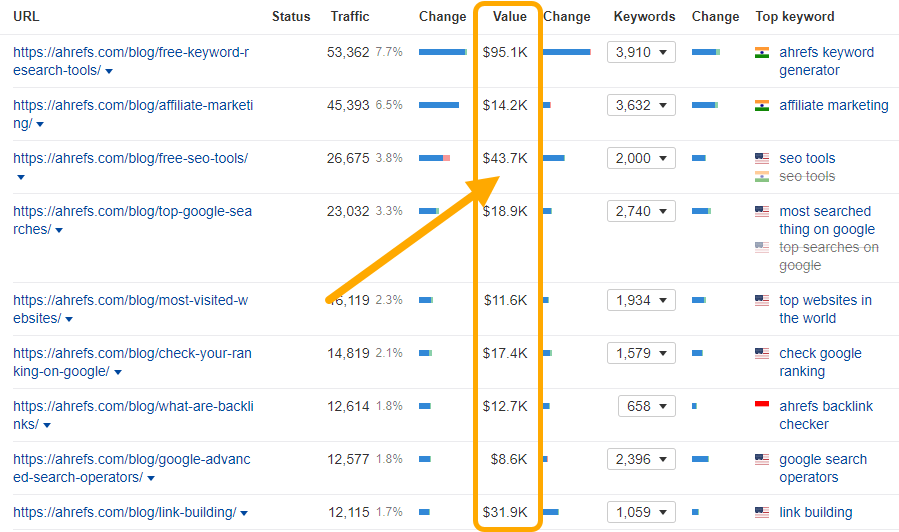
If we add up the site visitors worth of all of the pages in our weblog, we have now an estimated month-to-month site visitors worth of $790,000:
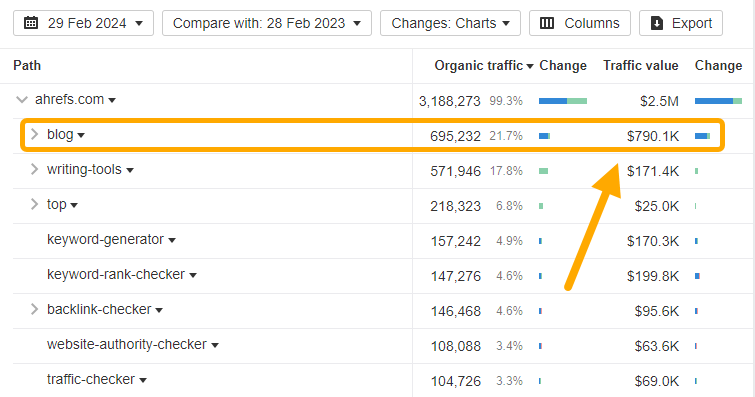
Put one other means, if we used paid promoting to get the identical quantity of visits from the identical key phrases, we’d have to spend round $790,000 on advertisements, each month.
Most content material is beneficial for longer than a single month, so we will multiply this month-to-month site visitors worth by the anticipated helpful “lifetime” of our content material. If we use two years as a place to begin, that offers us a lifetime site visitors worth of $18,960,000:
(Month-to-month site visitors worth * content material lifetime) = $790,900 * 24-months = $18,960,000We’ve over 2,000 weblog articles at Ahrefs, and we had been most likely by no means going to spend $19 million on paid promoting. However this calculation means that you can assign a greenback worth to your content material in a matter of seconds. It’s notably helpful if your organization not too long ago switched from a heavy reliance on paid promoting to content material advertising, letting you showcase the cash you’ve saved from the swap.
Let’s wrap up with a best-of-both-worlds method, similar to how we calculate ROI at Ahrefs:
Return from content material = (% of signups attributed to content material * complete signup income)
Each time a brand new buyer indicators up for Ahrefs, we ask them a query: The place did you hear about us?
Their reply is piped right into a devoted Slack channel, #registrations, which provides us a stay feed of recent signups and, crucially, how they found Ahrefs. Sam, our VP of Advertising, commonly makes use of this feed to work out the proportion of complete signups that may be attributed to his YouTube content material.
If I head to #registrations and run a seek for signups that talked about “youtube”, we will see over 34,000 those who immediately attributed their discovery of Ahrefs to Sam’s video content material:
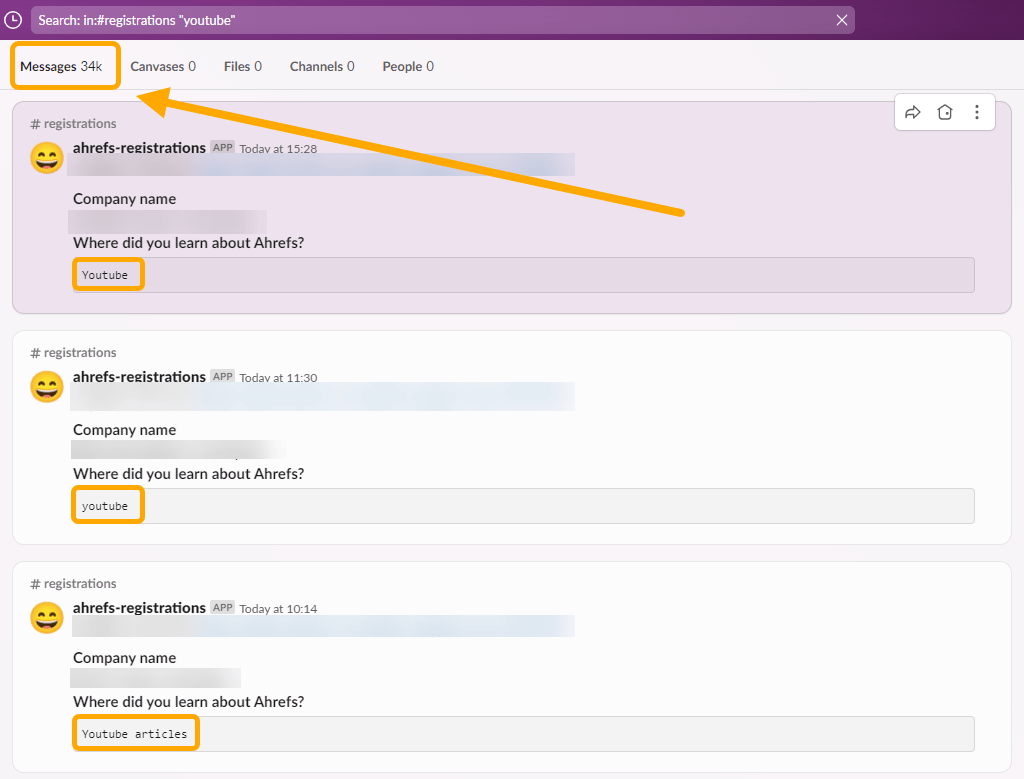
We will use this to estimate content material advertising ROI: if 33% of all respondents in a given month attribute their signing as much as YouTube, it will be pretty cheap to imagine that 33% of all signups got here from YouTube, and that 33% of all new income needs to be attributed to our video content material efforts.
If we assume a theoretical month-to-month income of $300,000, and that 1,000 of a complete 3,000 signups could possibly be attributed to “YouTube”, we will plug these values into our components for a return on content material of $100,000:
(33% of signups attributed to content material * $300,000) = $100,000This technique will underreport the variety of signups generated (individuals may misspell YouTube, or say “movies” as an alternative, or more than likely, not reply the query in any respect). The connection between new signups and new income may also be extra sophisticated than we assume right here (in case you have plenty of free customers, for instance).
But it surely has the good thing about making it straightforward to match to different advertising channels. If I seek for “google” in the identical #registration channel, I see 94,000 mentions—larger than Sam’s 34,000 YouTube mentions:
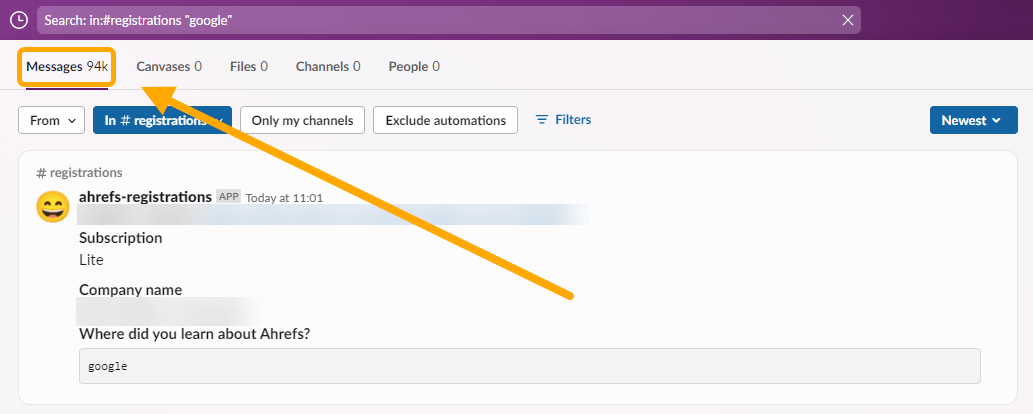
(Though he’s undoubtedly catching up…)
Closing ideas
There are tons of how to measure content material advertising ROI, and none of them are excellent. However for sensible functions, they don’t have to be.
Metrics, like content material advertising ROI, are most helpful as directional indicators. As an alternative of obsessing over excellent calculations, it’s higher to decide on a easy methodology, follow it constantly, and see the way it adjustments over time.

